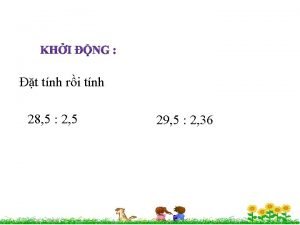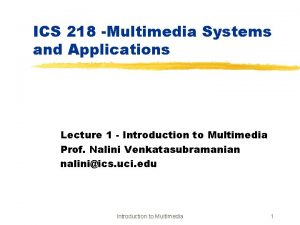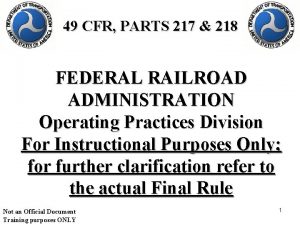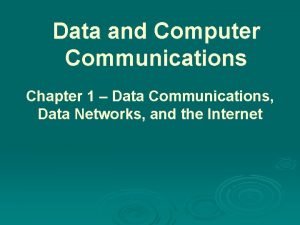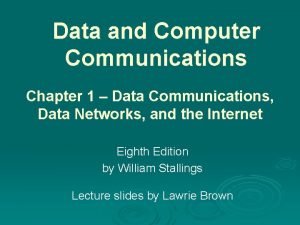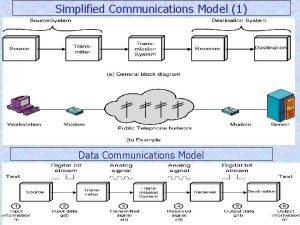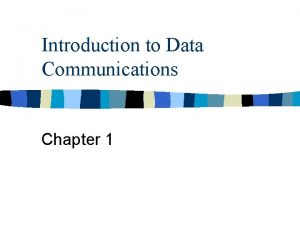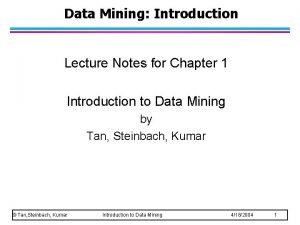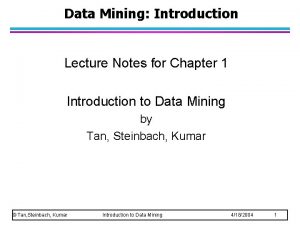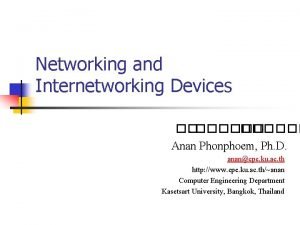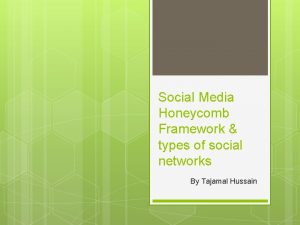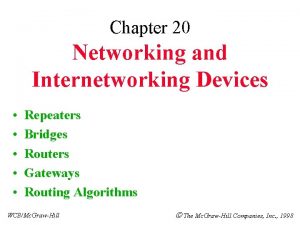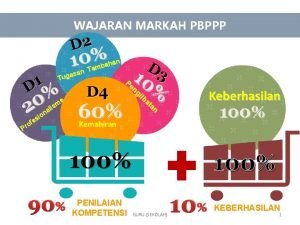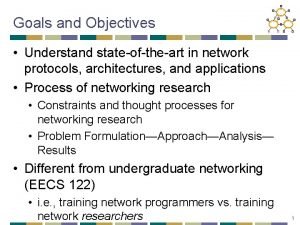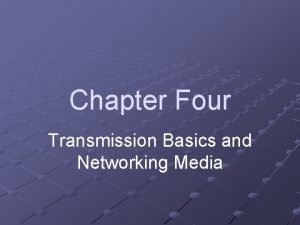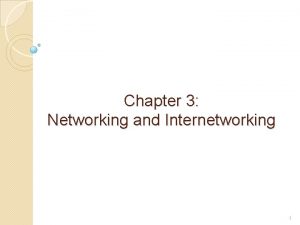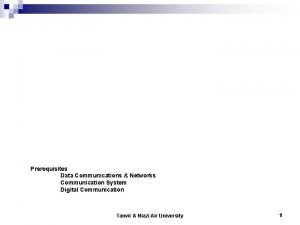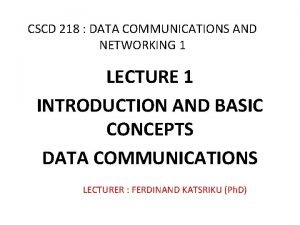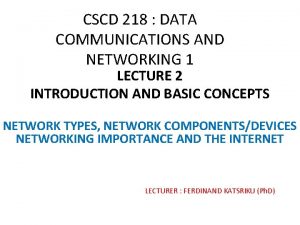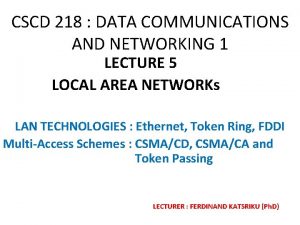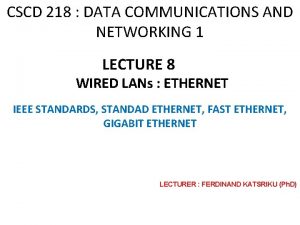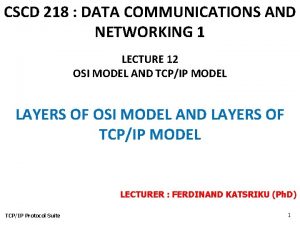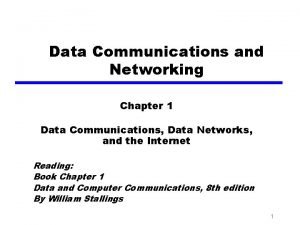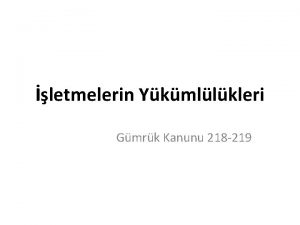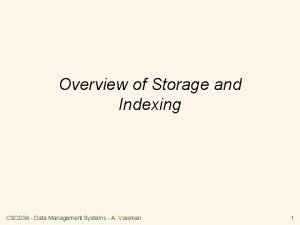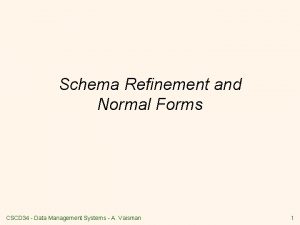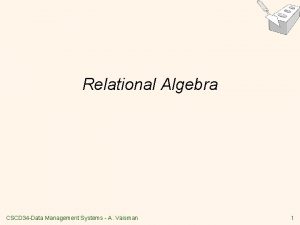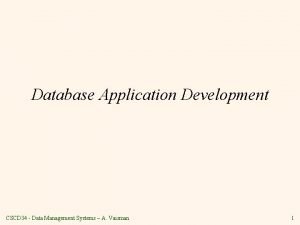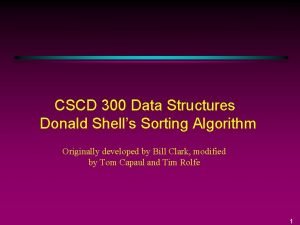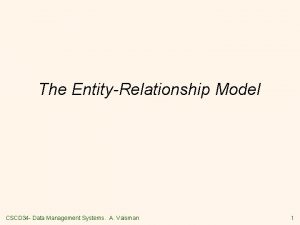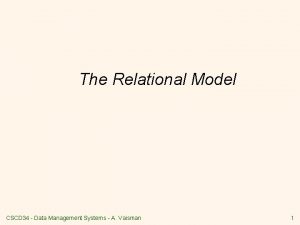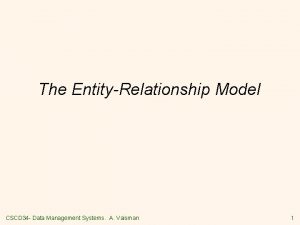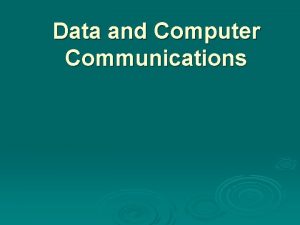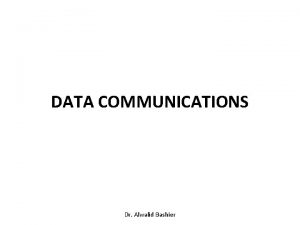CSCD 218 DATA COMMUNICATIONS AND NETWORKING 1 LECTURE
















































- Slides: 48

CSCD 218 : DATA COMMUNICATIONS AND NETWORKING 1 LECTURE 7 Data and Signals Analog and Digital, Transmission Impairment: Distortion, Noise, Attenuation. Performance : Bandwidth, Throughput, Latency LECTURER : FERDINAND KATSRIKU (Ph. D)

Question Why is the IP address : 127. 0. 0. 1 very important In computers ?

Lecture 7: Outline Data and Signals q 3. 1 Analog and Digital q 3. 2 Analog-to-Analog Conversion q 3. 3 Digital Signals q 3. 4 Transmission Impairment q 3. 5 Data-rate Limits q 3. 6 Performance

Data • Data = Entities that convey meaning within a computer system • Examples of data (captured and stored on storage devices) – Files on a hard drive – Movie on a DVD – Music on a CD • For transmission, Data (static entities) need to be converted into signals (dynamic entities)

Signal • Signal = Electric or electromagnetic encoding of data for transmission – Using a physical transmission medium – Using airwaves • Examples of signals (situations) – Telephone conversation over a telephone line – Live television news interview from Europe – Web page download over your telephone line via the Internet

Physical Layer To be transmitted, data must be transformed to electromagnetic signals.

ANALOG AND DIGITAL • Data can be analog or digital q Analog data refers to information that is continuous q Analog data take on continuous values q Analog signals can have an infinite number of values in a range q Digital data refers to information that has discrete states q Digital data take on discrete values q Digital signals can have only a limited number of values

ANALOG AND DIGITAL • Data can be analog or digital. Analog data are continuous and take continuous values. • Digital data have discrete states and take discrete values. Signals can be analog or digital. Analog signals can have an infinite number of values in a range; digital signals can have only a limited number of values.

Comparison of analog and digital Signals In data communications, we commonly use periodic analog signals and nonperiodic digital signals.

PERIODIC ANALOG SIGNALS Periodic analog signals can be classified as simple or composite. q A simple periodic analog signal, a sine wave, cannot be decomposed into simpler signals. q A composite periodic analog signal is composed of multiple sine waves.

SIGNAL AMPLITUDE

FREQUENCY • Frequency is the rate of change with respect to time. • Period refers to the amount of time, in seconds, a signal needs to complete 1 cycle. q. Change in a short span of time means high frequency. q Change over a long span of time means low frequency. q If a signal does not change at all, its frequency is zero q If a signal changes instantaneously, its frequency is infinite.

FREQUENCY AND PERIOD • Frequency and period are the inverse of each other. Units of period and frequency

TWO SIGNALS WITH THE SAME AMPLITUDE, BUT DIFFERENT FREQUENCIES

Examples : 1. The power we use at home has a frequency of 60 Hz. What is the period of this sine wave ? 2. The period of a signal is 100 ms. What is its frequency in kilohertz?

Solutions : 1. First we change l. OO ms to seconds, and then we calculate the frequency from the period (1 Hz = 10 -3 k. Hz). 2.

Phase • Phase describes the position of the waveform relative to time 0 Three sine waves with the same amplitude and frequency, but different phases

Example A sine wave is offset 1/6 cycle with respect to time 0. What is its phase in degrees and radians? Solution We know that 1 complete cycle is 360°. Therefore, 1/6 cycle is

Wavelength and Period Wavelength = Propagation speed x Period = Propagation speed / Frequency

Fourier Analysis According to Fourier analysis, any composite signal is a combination of simple sine waves with different frequencies, amplitudes, and phases. q If the composite signal is periodic, the decomposition gives a series of signals with discrete frequencies; q If the composite signal is nonperiodic, the decomposition gives a combination of sine waves with continuous frequencies.

A composite periodic signal Decomposition of the composite periodic signal in the time and frequency domains

Time and frequency domains of a nonperiodic signal q A nonperiodic composite signal o It can be a signal created by a microphone or a telephone set when a word or two is pronounced. o In this case, the composite signal cannot be periodic Øbecause that implies that we are repeating the same word or words with exactly the same tone.

Bandwidth and Signal frequency The bandwidth of a composite signal is the difference between the highest and the lowest frequencies contained in that signal.

Example 1 : If a periodic signal is decomposed into five sine waves with frequencies of 100, 300, 500, 700, and 900 Hz, what is its bandwidth? Draw the spectrum, assuming all components have a maximum amplitude of 10 V. Example 2 : A periodic signal has a bandwidth of 20 Hz. The highest frequency is 60 Hz. What is the lowest frequency? Draw the spectrum if the signal contains all frequencies of the same amplitude.

Solution 1 : Let fh be the highest frequency, fl the lowest frequency, and B the bandwidth. Then The spectrum has only five spikes, at 100, 300, 500, 700, and 900 Hz.

Solution 2 : Let fh be the highest frequency, fl the lowest frequency, and B the bandwidth. Then

Transmission Impairment q Signals travel through transmission media, which are not perfect. q The imperfection causes signal impairment. q This means that the signal at the beginning of the medium is not the same as the signal at the end of the medium. q What is sent is not what is received. q Three causes of impairment are attenuation, distortion, and noise.

Transmission Impairment : Attenuation

Transmission Impairment : Attenuation Decibel q To show that a signal has lost or gained strength, the unit of decibel is used. q Measures the relative strengths of two signals or one signal at two different points. q It is negative if a signal is attenuated and positive if a signal is amplified. Where P 1 and P 2 are the powers of a signal at points 1 and 2, respectively.

Transmission Impairment : Attenuation – Example 1 Suppose a signal travels through a transmission medium and its power is reduced to one-half. Example 2 A signal travels through an amplifier, and its power is increased 10 times. This means that P 2 = 10 P 1. What is the amplification (gain of power)?

Solution 1 This means that P 2 is (1/2)P 1. In this case, the attenuation (loss of power) can be calculated as : A loss of 3 d. B (– 3 d. B) is equivalent to losing one-half the power.

Solution 2 This means that P 2 = 10 P 1 Hence the amplification (or gain of power):

Example 3 One reason that engineers use the decibel to measure the changes in the strength of a signal is that decibel numbers can be added (or subtracted) when we are measuring several • points (cascading) instead of just two. A signal travels from point 1 to point 4. In this case, the decibel value can be calculated as

Distortion q Means signal changes its form or shape. q Can occur in a composite signal made of different frequencies. q Each signal component has its own propagation speed through a medium and, therefore its own delay in arriving at the final destination. q Differences in delay may create a difference in phase if the delay is not exactly the same as the period duration. q In other words, signal components at the receiver have phases different from what they had at the sender. The shape of the composite signal is therefore not the same

Distortion •

Noise q Another cause of impairment. Several types, such as thermal noise, induced noise, crosstalk, and impulse noise, may corrupt the signal. q Thermal noise is the random motion of electrons in a wire which creates an extra signal not originally sent by the transmitter. q Induced noise comes from sources such as motors and appliances. These devices act as a sending antenna, and the transmission medium acts as the receiving antenna. q Crosstalk is the effect of one wire on the other. One wire acts as a sending antenna and the other as the receiving antenna. q Impulse noise is a spike (a signal with high energy in a very short time) that comes from power lines, lightning, and so on.

Noise

Signal-to-Noise Ration (SNR) q The signal-to-noise ratio is defined as : SNR = average signal power average noise power q SNR is actually the ratio of what is wanted (signal) to what is not wanted (noise). q A high SNR means the signal is less corrupted by noise; a low SNR means the signal is more corrupted by noise. q Because SNR is the ratio of two powers, it is often described in decibel units, SNRd. B, defined as : SNRdb = 10 log 10 SNR

Example : • The power of a signal is 10 m. W and the power of the noise is 1 μW; what are the values of SNR and SNRd. B ? Solution : The values of SNR and SNRd. B can be calculated as follows:

Two cases of SNR : a high SNR and a low SNR

Channel (Shannon) Capacity q It denotes the upper limit to a channel’s (transmission medium’s) capacity to transfer data. q Claude Shannon determined theoretical maximum data rate capacity of a communication channel. q Basically dependent on the bandwidth of the channel, the signal power and the noise power. q In reality, we can not have a noiseless channel For noisy channel, Capacity = Bandwith x log 2(1+SNR) Where C is the information rate in bps, B is the bandwidth of the line in Hz, S is the signal power in watts and N is the random power in watts.

Channel (Shannon) Capacity : Example 1 Let’s calculate theoretical highest bit rate of a regular telephone line. A telephone line normally has a bandwidth of 3000. The signal-to-noise ratio is usually 3162. What is the channel capacity? Example 2 The signal-to-noise ratio is often given in decibels. Assume that SNRd. B = 36 and the channel bandwidth is 2 MHz. What is theoretical channel capacity?

Solution 1 This means that the highest bit rate for a telephone line is 34. 860 kbps. If we want to send data faster than this, we can either increase the bandwidth of the line or improve the signal-tonoise ratio. Solution 2

Performance One important issue in networking is the performance of the network—how good is it? In networking, we use the term bandwidth in two contexts The first, bandwidth in hertz, refers to the range of frequencies in a composite signal or the range of frequencies that a channel can pass. The second, bandwidth in bits per second, refers to the speed of bit transmission in a channel or link.

Bandwidth : Example q The bandwidth of a subscriber line is 4 k. Hz for voice or data. q The bandwidth of this line for data transmission can be up to 56, 000 bps using a sophisticated modem to change the digital signal to analog. q If the telephone company improves the quality of the line and increases the bandwidth to 8 k. Hz, we can send 112, 000 bps.

Throughput q Is a measure of how fast we can actually send data through a network. q In other words, the bandwidth is a potential measurement of a link; the throughput is an actual measurement of how fast we can send data. q For example ; Imagine a highway designed to transmit 1000 cars per minute from one point to another. However, if there is congestion on the road, this figure may be reduced to 100 cars per minute. The bandwidth is 1000 cars per minute; the throughput is 100 cars per minute.

Throughput : Example • A network with bandwidth of 10 Mbps can pass only an average of 12, 000 frames per minute with each frame carrying an average of 10, 000 bits. What is the throughput of this network? Solution We can calculate throughput as The throughput is almost one-fifth of the bandwidth in this case.

Solution q The latency or delay defines how long it takes for an entire message to completely arrive at the destination from the time the first bit is sent out from the source. q We can say that latency is made of four components: propagation time, transmission time, queuing time and processing delay. Latency = propagation time +transmission time +queuing time + processing delay
 Business data communications and networking
Business data communications and networking Business data communication and networking
Business data communication and networking Introduction to data communications and networking
Introduction to data communications and networking Business data communications and networking
Business data communications and networking Sdn overview
Sdn overview 28,5:2,5
28,5:2,5 Ics multimedia
Ics multimedia Da teu fardo a jesus
Da teu fardo a jesus 49 cfr 217
49 cfr 217 Crisis communication lecture
Crisis communication lecture 01:640:244 lecture notes - lecture 15: plat, idah, farad
01:640:244 lecture notes - lecture 15: plat, idah, farad Data communication assignment
Data communication assignment Means communication at a distance
Means communication at a distance Data and computer communications 10th edition
Data and computer communications 10th edition Data & computer communications
Data & computer communications Data and computer communications
Data and computer communications William stallings data and computer communications
William stallings data and computer communications Jellyfish networking data centers randomly
Jellyfish networking data centers randomly Hp a5820
Hp a5820 Data center switching gartner
Data center switching gartner Model of data communication
Model of data communication Introduction to data communications
Introduction to data communications Exploratory data analysis lecture notes
Exploratory data analysis lecture notes Bayesian classification in data mining lecture notes
Bayesian classification in data mining lecture notes Data mining lecture notes
Data mining lecture notes Data visualization lecture
Data visualization lecture Data mining lecture notes
Data mining lecture notes Data mining lecture notes
Data mining lecture notes Decision tree
Decision tree Disadvantages of social network
Disadvantages of social network What is persuasion and networking
What is persuasion and networking Speed networking advantages and disadvantages
Speed networking advantages and disadvantages Essay advantages and disadvantages
Essay advantages and disadvantages Networking and internetworking devices
Networking and internetworking devices Jalinan dan jaringan dalam pbppp
Jalinan dan jaringan dalam pbppp Pengertian kolaborasi jaringan
Pengertian kolaborasi jaringan Goals of network layer
Goals of network layer Analog and digital signals in computer networking
Analog and digital signals in computer networking Transmission basics and networking media
Transmission basics and networking media Poznan supercomputing and networking center
Poznan supercomputing and networking center Networking and internetworking
Networking and internetworking What is crc in computer network
What is crc in computer network Optical switching and networking
Optical switching and networking Nims communications and information management
Nims communications and information management Ministry of transport cyprus
Ministry of transport cyprus Global marketing and communications
Global marketing and communications Designing and managing integrated marketing communications
Designing and managing integrated marketing communications Digital communications and networks impact factor
Digital communications and networks impact factor K state communications and marketing
K state communications and marketing





